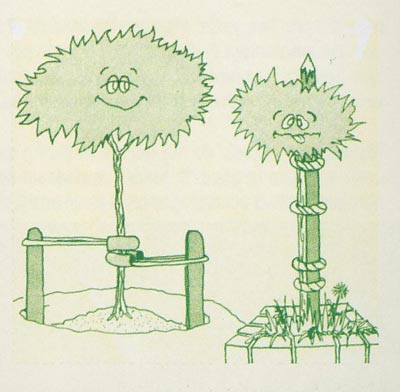Staking
 Not all trees require staking. In fact, improper staking may seriously weaken, deform or injure a tree. A tree left unstaked, with its top allowed to move in the wind will develop a better root system, have greater trunk taper and thickness, and will have less wind resistance than a rigidly staked tree. In some cases, a young spindly tree may require staking for a short time to hold it upright until it develops a stronger trunk. Always remove the nursery stake. A tree tied to only one stake is subject to trunk and branch wounds, produces a smaller root system and blows over more readily when the stake is finally removed. If you need to stake a tree, do it correctly.
Not all trees require staking. In fact, improper staking may seriously weaken, deform or injure a tree. A tree left unstaked, with its top allowed to move in the wind will develop a better root system, have greater trunk taper and thickness, and will have less wind resistance than a rigidly staked tree. In some cases, a young spindly tree may require staking for a short time to hold it upright until it develops a stronger trunk. Always remove the nursery stake. A tree tied to only one stake is subject to trunk and branch wounds, produces a smaller root system and blows over more readily when the stake is finally removed. If you need to stake a tree, do it correctly.
When staking, use two stakes, one on either side of the root ball. Pound the stakes in deep enough so the stakes can’t move in the wind. Make stakes as short as possible. To find the right height, move your hand up the tree trunk until the tree just remains upright- this is where to place the ties. Use two brad ties, of flexible material. Cut the stakes two to three inches above the ties. Leaving the stakes too tall will cause injuries to the tree when the wind rubs it against the stakes. Remove the stakes as soon as the tree will stand on its own. Most trees will not need to be staked longer than a year.

